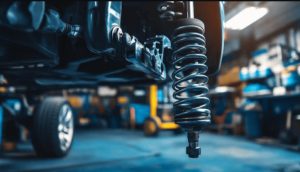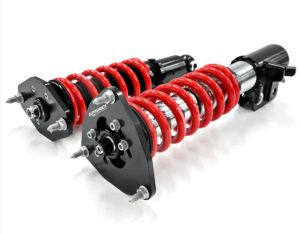Shock absorbers play a vital role in keeping your vehicle stable, comfortable, and safe. While they’re essential in all driving conditions, heavy-duty driving, towing, and carrying significant loads put added strain on these components. If you frequently haul cargo, tow trailers, or drive off-road, your shock absorbers must be up to the task — and properly maintained.
In this article, we’ll explain how towing and heavy loads affect shock absorbers, highlight signs of wear, provide tips for extending their lifespan, and help you choose the best shocks for demanding conditions.
Understanding the Role of Shock Absorbers in Load Management

Shock absorbers control suspension movement by converting kinetic energy from road impacts and body movement into heat. When your vehicle carries extra weight, this movement increases dramatically — placing more stress on the shocks and reducing their efficiency.
| Function | Impact Under Load |
|---|---|
| Damping | More aggressive damping needed to stabilize movement |
| Heat Dissipation | Increased friction generates more heat |
| Suspension Travel | Reduced due to additional compression from the load |
| Ride Control | Greater potential for body roll and bounce |
How Towing Affects Shock Absorbers
Towing a trailer adds significant weight to the rear of your vehicle, often changing its center of gravity and affecting handling. Shock absorbers must work harder to maintain control and prevent excessive bounce or sway — especially on uneven roads.
Towing-Related Effects:
-
Increased rear suspension sag
-
Longer stopping distances
-
Greater likelihood of bottoming out
-
Faster wear and fluid overheating in shocks
Signs Your Shocks Are Struggling with Load
Heavy-duty use accelerates shock absorber wear. Keep an eye out for these warning signs:
| Symptom | Possible Cause |
|---|---|
| Bouncy or unstable ride | Weak or overheated shocks |
| Nose-diving when braking | Front shocks failing under load |
| Excessive body sway | Inadequate damping control from rear shocks |
| Uneven tire wear | Poor suspension alignment due to weak shocks |
| Leaking oil or visible damage | Shocks overwhelmed or physically degraded |
Choosing the Right Shock Absorbers for Towing & Load-Bearing
If you’re using your vehicle for towing, hauling, or heavy-duty driving, standard OEM shocks may not be enough. You’ll want to consider performance-oriented or heavy-duty shock absorber options.
| Type | Best For |
|---|---|
| Heavy-Duty Twin-Tube | Light towing, moderate load, mixed use |
| Monotube Gas Shocks | Daily towing, heavy loads, off-road terrain |
| Adjustable Shocks | Versatility for load variation and ride comfort |
| Air Shocks | Trucks and vans with variable load/towing demands |
| Load-Leveling Shocks | Consistent height under heavy loads or trailers |
Heavy-Duty Driving Tips: Protecting Your Shocks
Driving with heavy loads or towing doesn’t have to destroy your suspension — if you follow some smart practices.
Best Practices for Longevity:
| Tip | Why It Matters |
|---|---|
| Don’t overload your vehicle | Prevents over-compression of suspension components |
| Upgrade to heavy-duty shocks | Provides better damping and durability |
| Maintain correct tire pressure | Ensures balanced load distribution |
| Use weight distribution hitches | Reduces stress on rear suspension and shocks |
| Inspect shocks regularly | Detect leaks, rust, and wear early |
| Let shocks cool after intense towing | Prevents heat-related degradation |
| Avoid aggressive driving with load | Minimizes excessive suspension compression |
Shock Absorbers vs. Suspension Upgrades

While shocks are critical, they’re not the only component affected by load. Consider a full suspension solution if you frequently carry weight:
| Component | Upgrade Option | Benefit |
|---|---|---|
| Springs | Heavy-duty coil or leaf springs | Better support under load |
| Bushings | Polyurethane bushings | More durability than rubber |
| Sway bars | Thicker or adjustable sway bars | Reduced body roll |
| Struts & Mounts | Reinforced struts | Improved longevity and strength |
Maintenance Schedule for Shock Absorbers Under Load
| Task | Recommended Interval |
|---|---|
| Visual inspection for leaks | Every 10,000 km or before long trips |
| Performance test (bounce test) | Monthly |
| Replace shocks | Every 60,000–80,000 km (sooner for towing) |
| Check bushings and mounts | Every oil change |
| Inspect tires for uneven wear | Every rotation or 10,000 km |
Conclusion
Towing and heavy loads amplify the demands on your suspension system — especially on your shock absorbers. If you regularly tow a trailer, haul equipment, or navigate rough roads, upgrading your shocks is not just a good idea — it’s essential.
Proper shocks will help your vehicle maintain stability, control, and safety, even under stress. By choosing the right type, following regular maintenance, and driving smartly, you can prevent premature wear and keep your ride smooth and secure.
buy Shock Absorbers online — Discover a wide range of high-performance and heavy-duty shocks that keep your vehicle ready for any task — from light towing to full commercial loads.